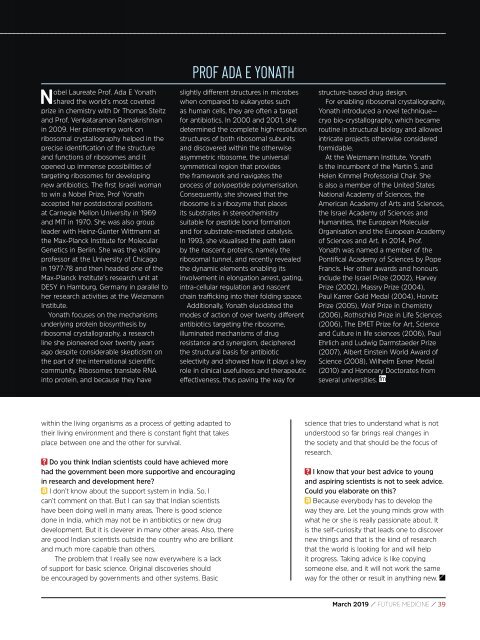March 2019 digital v1
Create successful ePaper yourself
Turn your PDF publications into a flip-book with our unique Google optimized e-Paper software.
Nobel Laureate Prof. Ada E Yonath<br />
shared the world’s most coveted<br />
prize in chemistry with Dr Thomas Steitz<br />
and Prof. Venkataraman Ramakrishnan<br />
in 2009. Her pioneering work on<br />
ribosomal crystallography helped in the<br />
precise identification of the structure<br />
and functions of ribosomes and it<br />
opened up immense possibilities of<br />
targeting ribosomes for developing<br />
new antibiotics. The first Israeli woman<br />
to win a Nobel Prize, Prof Yonath<br />
accepted her postdoctoral positions<br />
at Carnegie Mellon University in 1969<br />
and MIT in 1970. She was also group<br />
leader with Heinz-Gunter Wittmann at<br />
the Max-Planck Institute for Molecular<br />
Genetics in Berlin. She was the visiting<br />
professor at the University of Chicago<br />
in 1977-78 and then headed one of the<br />
Max-Planck Institute’s research unit at<br />
DESY in Hamburg, Germany in parallel to<br />
her research activities at the Weizmann<br />
Institute.<br />
Yonath focuses on the mechanisms<br />
underlying protein biosynthesis by<br />
ribosomal crystallography, a research<br />
line she pioneered over twenty years<br />
ago despite considerable skepticism on<br />
the part of the international scientific<br />
community. Ribosomes translate RNA<br />
into protein, and because they have<br />
PROF ADA E YONATH<br />
slightly different structures in microbes<br />
when compared to eukaryotes such<br />
as human cells, they are often a target<br />
for antibiotics. In 2000 and 2001, she<br />
determined the complete high-resolution<br />
structures of both ribosomal subunits<br />
and discovered within the otherwise<br />
asymmetric ribosome, the universal<br />
symmetrical region that provides<br />
the framework and navigates the<br />
process of polypeptide polymerisation.<br />
Consequently, she showed that the<br />
ribosome is a ribozyme that places<br />
its substrates in stereochemistry<br />
suitable for peptide bond formation<br />
and for substrate-mediated catalysis.<br />
In 1993, she visualised the path taken<br />
by the nascent proteins, namely the<br />
ribosomal tunnel, and recently revealed<br />
the dynamic elements enabling its<br />
involvement in elongation arrest, gating,<br />
intra-cellular regulation and nascent<br />
chain trafficking into their folding space.<br />
Additionally, Yonath elucidated the<br />
modes of action of over twenty different<br />
antibiotics targeting the ribosome,<br />
illuminated mechanisms of drug<br />
resistance and synergism, deciphered<br />
the structural basis for antibiotic<br />
selectivity and showed how it plays a key<br />
role in clinical usefulness and therapeutic<br />
effectiveness, thus paving the way for<br />
structure-based drug design.<br />
For enabling ribosomal crystallography,<br />
Yonath introduced a novel technique—<br />
cryo bio-crystallography, which became<br />
routine in structural biology and allowed<br />
intricate projects otherwise considered<br />
formidable.<br />
At the Weizmann Institute, Yonath<br />
is the incumbent of the Martin S. and<br />
Helen Kimmel Professorial Chair. She<br />
is also a member of the United States<br />
National Academy of Sciences, the<br />
American Academy of Arts and Sciences,<br />
the Israel Academy of Sciences and<br />
Humanities, the European Molecular<br />
Organisation and the European Academy<br />
of Sciences and Art. In 2014, Prof.<br />
Yonath was named a member of the<br />
Pontifical Academy of Sciences by Pope<br />
Francis. Her other awards and honours<br />
include the Israel Prize (2002), Harvey<br />
Prize (2002), Massry Prize (2004),<br />
Paul Karrer Gold Medal (2004), Horvitz<br />
Prize (2005), Wolf Prize in Chemistry<br />
(2006), Rothschild Prize in Life Sciences<br />
(2006), The EMET Prize for Art, Science<br />
and Culture in life sciences (2006), Paul<br />
Ehrlich and Ludwig Darmstaeder Prize<br />
(2007), Albert Einstein World Award of<br />
Science (2008), Wilhelm Exner Medal<br />
(2010) and Honorary Doctorates from<br />
several universities.<br />
within the living organisms as a process of getting adapted to<br />
their living environment and there is constant fight that takes<br />
place between one and the other for survival.<br />
Do you think Indian scientists could have achieved more<br />
had the government been more supportive and encouraging<br />
in research and development here?<br />
I don’t know about the support system in India. So, I<br />
can’t comment on that. But I can say that Indian scientists<br />
have been doing well in many areas. There is good science<br />
done in India, which may not be in antibiotics or new drug<br />
development. But it is cleverer in many other areas. Also, there<br />
are good Indian scientists outside the country who are brilliant<br />
and much more capable than others.<br />
The problem that I really see now everywhere is a lack<br />
of support for basic science. Original discoveries should<br />
be encouraged by governments and other systems. Basic<br />
science that tries to understand what is not<br />
understood so far brings real changes in<br />
the society and that should be the focus of<br />
research.<br />
I know that your best advice to young<br />
and aspiring scientists is not to seek advice.<br />
Could you elaborate on this?<br />
Because everybody has to develop the<br />
way they are. Let the young minds grow with<br />
what he or she is really passionate about. It<br />
is the self-curiosity that leads one to discover<br />
new things and that is the kind of research<br />
that the world is looking for and will help<br />
it progress. Taking advice is like copying<br />
someone else, and it will not work the same<br />
way for the other or result in anything new.<br />
<strong>March</strong> <strong>2019</strong> / FUTURE MEDICINE / 39


















